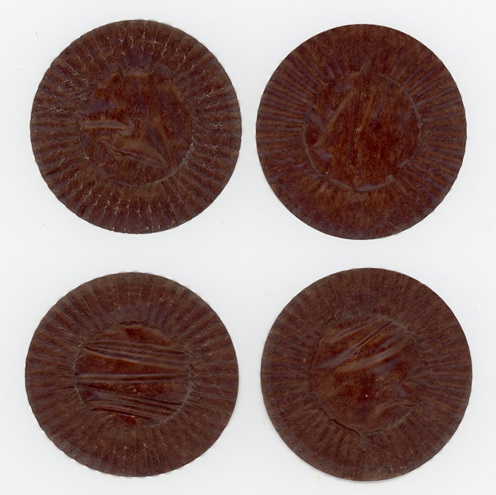
Photo of the Day


LIFE IN THE LOWER SUSQUEHANNA RIVER WATERSHED
A Natural History of Conewago Falls—The Waters of Three Mile Island

It’s tough being good-looking and liked by so many. You’ve got to watch out, because popularity makes you a target. Others get jealous and begin a crusade to have you neutralized and removed from the spotlight. They’ll start digging to find your little weaknesses and flaws, then they’ll exploit them to destroy your reputation. Next thing you know, people look at you as some kind of hideous scoundrel.
Today, bright afternoon sunshine and a profusion of blooming wildflowers coaxed butterflies into action. It was one of those days when you don’t know where to look first.
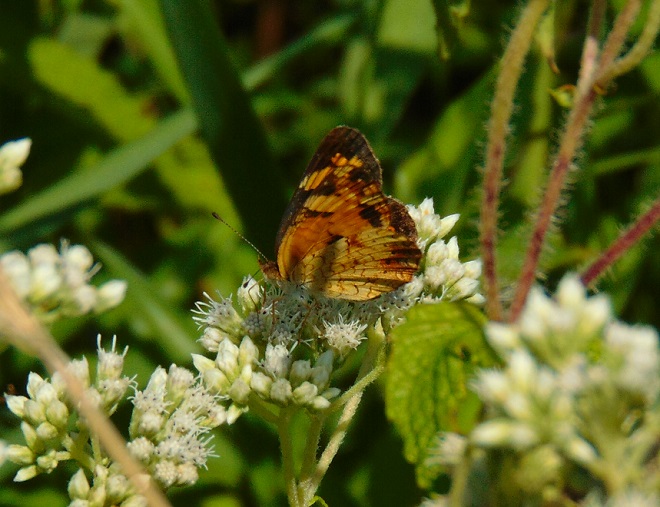


Purple Loosestrife (Lythrum salicaria) has a bad reputation. Not native to the Americas, this prolific seed producer began spreading aggressively into many wetlands following its introduction. It crowds out native plant species and can have a detrimental impact on other aquatic life. Stands of loosestrife in slow-moving waters can alter flows, trap sediment, and adversely modify the morphology of waterways. Expensive removal and biological control are often needed to protect critical habitat.
The dastardly Purple Loosestrife may have only two positive attributes. First, it’s a beautiful plant. And second, it’s popular; butterflies and other pollinators find it to be irresistible and go wild over the nectar.



Don’t you just adore the wonderful butterflies. Everybody does. Just don’t tell anyone that they’re pollinating those dirty filthy no-good Purple Loosestrife plants.
SOURCES
Brock, Jim P., and Kenn Kaufman. 2003. Butterflies of North America. Houghton Mifflin Company. New York.
Newcomb, Lawrence. 1977. Newcomb’s Wildflower Guide. Little, Brown and Company. Boston, Massachusetts.
There’s something frightening going on down there. In the sand, beneath the plants on the shoreline, there’s a pile of soil next to a hole it’s been digging. Now, it’s dragging something toward the tunnel it made. What does it have? Is that alive?
We know how the system works, the food chain that is. The small stuff is eaten by the progressively bigger things, and there are fewer of the latter than there are of the former, thus the whole network keeps operating long-term. Some things chew plants, others devour animals whole or in part, and then there are those, like us, that do both. In the natural ecosystem, predators keep the numerous little critters from getting out of control and decimating certain other plant or animal populations and wrecking the whole business. When man brings an invasive and potentially destructive species to a new area, occasionally we’re fortunate enough to have a native species adapt and begin to keep the invader under control by eating it. It maintains the balance. It’s easy enough to understand.

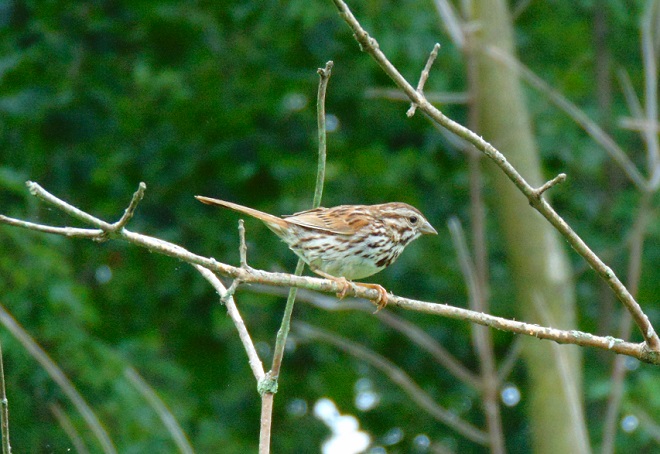
Late summer days are marked by a change in the sounds coming from the forests surrounding the falls. For birds, breeding season is ending, so the males cease their chorus of songs and insects take over the musical duties. The buzzing calls of male “Annual Cicadas” (Neotibicen species) are the most familiar. The female “Annual Cicada” lays her eggs in the twigs of trees. After hatching, the nymphs drop to the ground and burrow into the soil to live and feed along tree roots for the next two to five years. A dry exoskeleton clinging to a tree trunk is evidence that a nymph has emerged from its subterranean haunts and flown away as an adult to breed and soon thereafter die. Flights of adult “Annual Cicadas” occur every year, but never come anywhere close to reaching the enormous numbers of “Periodical Cicadas” (Magicicada species). The three species of “Periodical Cicadas” synchronize their life cycles throughout their combined regional populations to create broods that emerge as spectacular flights once every 13 or 17 years.
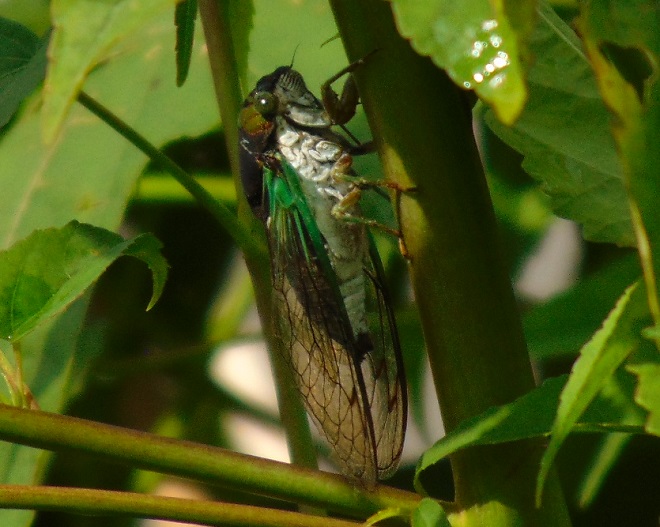
For the adult cicada, there is danger, and that danger resembles an enormous bee. It’s an Eastern Cicada Killer (Specius speciosus) wasp, and it will latch onto a cicada and begin stinging while both are in flight. The stings soon paralyze the screeching, panicked cicada. The Cicada Killer then begins the task of airlifting and/or dragging its victim to the lair it has prepared. The cicada is placed in one of more than a dozen cells in the tunnel complex where it will serve as food for the wasp’s larvae. The wasp lays an egg on the cicada, then leaves and pushes the hole closed. The egg hatches in a several days and the larval grub is on its own to feast upon the hapless cicada.

Other species in the Solitary Wasp family (Sphecidae) have similar life cycles using specific prey which they incapacitate to serve as sustenance for their larvae.

The Solitary Wasps are an important control on the populations of their respective prey. Additionally, the wasp’s bizarre life cycle ensures a greater survival rate for its own offspring by providing sufficient food for each of its progeny before the egg beginning its life is ever put in place. It’s complete family planning.
The cicadas reproduce quickly and, as a species, seem to endure the assault by Cicada Killers, birds, and other predators. The Periodical Cicadas (Magicicada), with adult flights occurring as a massive swarm of an entire population every thirteen or seventeen years, survive as species by providing predators with so ample a supply of food that most of the adults go unmolested to complete reproduction. Stay tuned, 2021 is due to be the next Periodical Cicada year in the vicinity of Conewago Falls.
SOURCES
Eaton, Eric R., and Kenn Kaufman. 2007. Kaufman Field Guide to Insects of North America. Houghton Mifflin Company. New York.
The tall seed-topped stems swaying in a summer breeze are a pleasant scene. And the colorful autumn shades of blue, orange, purple, red, and, of course, green leaves on these clumping plants are nice. But of the multitude of flowering plants, Big Bluestem, Freshwater Cordgrass, and Switchgrass aren’t much of a draw. No self-respecting bloom addict is going out of their way to have a gander at any grass that hasn’t been subjugated and tamed by a hideous set of spinning steel blades. Grass flowers…are you kidding?

O.K., so you need something more. Here’s more.
Meet the Partridge Pea (Chamaecrista fasciculata). It’s an annual plant growing in the Riverine Grasslands at Conewago Falls as a companion to Big Bluestem. It has a special niche growing in the sandy and, in summertime, dry soils left behind by earlier flooding and ice scour. The divided leaves close upon contact and also at nightfall. Bees and other pollinators are drawn to the abundance of butter-yellow blossoms. Like the familiar pea of the vegetable garden, the flowers are followed by flat seed pods.

But wait, here’s more.
In addition to its abundance in Conewago Falls, the Halberd-leaved Rose Mallow (Hibiscus laevis) is the ubiquitous water’s edge plant along the free-flowing Susquehanna River for miles downstream. It grows in large clumps, often defining the border between the emergent zone and shore-rooted plants. It is particularly successful in accumulations of alluvium interspersed with heavier pebbles and stone into which the roots will anchor to endure flooding and scour. Such substrate buildup around the falls, along mid-river islands, and along the shores of the low-lying Riparian Woodlands immediately below the falls are often quite hospitable to the species.

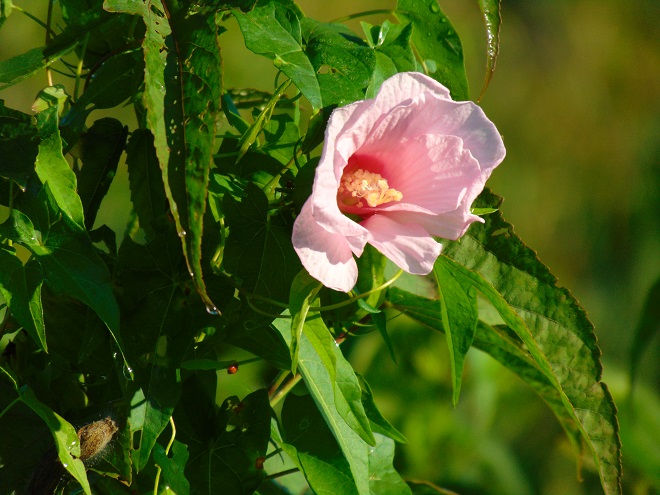

A second native wildflower species in the genus Hibiscus is found in the Conewago Falls floodplain, this one in wetlands. The Swamp Rose Mallow (H. moscheutos) is similar to Halberd-leaved Rose Mallow, but sports more variable and colorful blooms. The leaves are toothed without the deep halberd-style lobes and, like the stems, are downy. As the common name implies, it requires swampy habitat with ample water and sunlight.


In summary, we find Partridge Pea in the Riverine Grasslands growing in sandy deposits left by flood and ice scour. We find Halberd-leaved Rose Mallow rooted at the border between shore and the emergent zone. We find Swamp Rose Mallow as an emergent in the wetlands of the floodplain. And finally, we find marshmallows in only one location in the area of Conewago Falls. Bon ap’.

SOURCES
Newcomb, Lawrence. 1977. Newcomb’s Wildflower Guide. Little, Brown and Company. Boston, Massachusetts.
She ate only toaster pastries…that’s it…nothing else. Every now and then, on special occasions, when a big dinner was served, she’d have a small helping of mashed potatoes, no gravy, just plain, thank you. She received all her nutrition from several meals a week of macaroni and cheese assembled from processed ingredients found in a cardboard box. It contains eight essential vitamins and minerals, don’t you know? You remember her, don’t you?
Adult female butterflies must lay their eggs where the hatched larvae will promptly find the precise food needed to fuel their growth. These caterpillars are fussy eaters, with some able to feed upon only one particular species or genus of plant to grow through the five stages, the instars, of larval life. The energy for their fifth molt into a pupa, known as a chrysalis, and metamorphosis into an adult butterfly requires mass consumption of the required plant matter. Their life cycle causes most butterflies to be very habitat specific. These splendid insects may visit the urban or suburban garden as adults to feed on nectar plants, however, successful reproduction relies upon environs which include suitable, thriving, pesticide-free host plants for the caterpillars. Their survival depends upon more than the vegetation surrounding the typical lawn will provide.
The Monarch (Danaus plexippus), a butterfly familiar in North America for its conspicuous autumn migrations to forests in Mexico, uses the milkweeds (Asclepias) almost exclusively as a host plant. Here at Conewago Falls, wetlands with Swamp Milkweed (Asclepias incarnata) and unsprayed clearings with Common Milkweed (A. syriaca) are essential to the successful reproduction of the species. Human disturbance, including liberal use of herbicides, and invasive plant species can diminish the biomass of the Monarch’s favored nourishment, thus reducing significantly the abundance of the migratory late-season generation.



Butterflies are good indicators of the ecological health of a given environment. A diversity of butterfly species in a given area requires a wide array of mostly indigenous plants to provide food for reproduction. Let’s have a look at some of the species seen around Conewago Falls this week…








The spectacularly colorful butterflies are a real treat on a hot summer day. Their affinity for showy plants doubles the pleasure.
By the way, I’m certain by now you’ve recalled that fussy eater…and how beautiful she grew up to be.
SOURCES
Brock, Jim P., and Kaufman, Kenn. 2003. Butterflies of North America. Houghton Mifflin Company. New York, NY.